
Fundamentals
The fundamental comprehension of Amino Acids begins with recognizing them as the basic building blocks of life, the molecular units that link together to form proteins. In the intricate biological architecture of human hair, these compounds hold a central place, forming the very foundation of its structure. Hair, a fibrous protein, owes its remarkable strength, elasticity, and distinctive texture to the precise arrangement and bonding of various Amino Acids.
Each of these small organic compounds contains an amino group, a carboxyl group, a hydrogen atom, and a unique side chain, all attached to a central carbon atom. This side chain is what gives each Amino Acid its particular properties, influencing how it interacts with others to create the complex three-dimensional forms of proteins.
For textured hair, especially those with coils, kinks, and curls, the significance of Amino Acids is particularly pronounced. The unique helical shape of these hair strands, so celebrated in Black and mixed-race hair heritage, is a direct consequence of the specific Amino Acids present and the way they bond. Consider the primary protein in hair, Keratin, which is abundant in a sulfur-containing Amino Acid called cysteine.
Cysteine residues are instrumental in forming strong chemical links known as disulfide bonds, which are crucial for maintaining the hair’s shape and mechanical strength. The more tightly coiled a hair strand, the more concentrated and unevenly distributed these disulfide bonds tend to be, contributing to the characteristic spring and resilience of textured hair.
Understanding the role of Amino Acids in hair health is not merely a scientific pursuit; it is a connection to ancestral wisdom. For generations, communities have intuitively understood the importance of nourishing hair, often through diets rich in protein and natural ingredients that provided these essential building blocks. The practices passed down through lineages, from traditional oiling rituals to the use of specific plant-based remedies, implicitly supported the very protein structures that Amino Acids compose. This knowledge, though not always articulated in biochemical terms, speaks to a deep, inherited understanding of hair’s intrinsic needs.
Amino Acids are the foundational units of hair’s strength and unique texture, particularly for coils and curls, echoing ancestral care practices.
The daily experiences of hair, from exposure to environmental elements to the gentle manipulation of styling, all interact with the integrity of these protein structures. When hair is compromised by external stressors, such as harsh chemicals or excessive heat, the bonds between Amino Acids can weaken or break, leading to dryness, brittleness, and a loss of definition. This foundational understanding allows us to appreciate why historical hair care emphasized protection and gentle nourishment, practices that inherently preserved the protein integrity of the hair shaft.
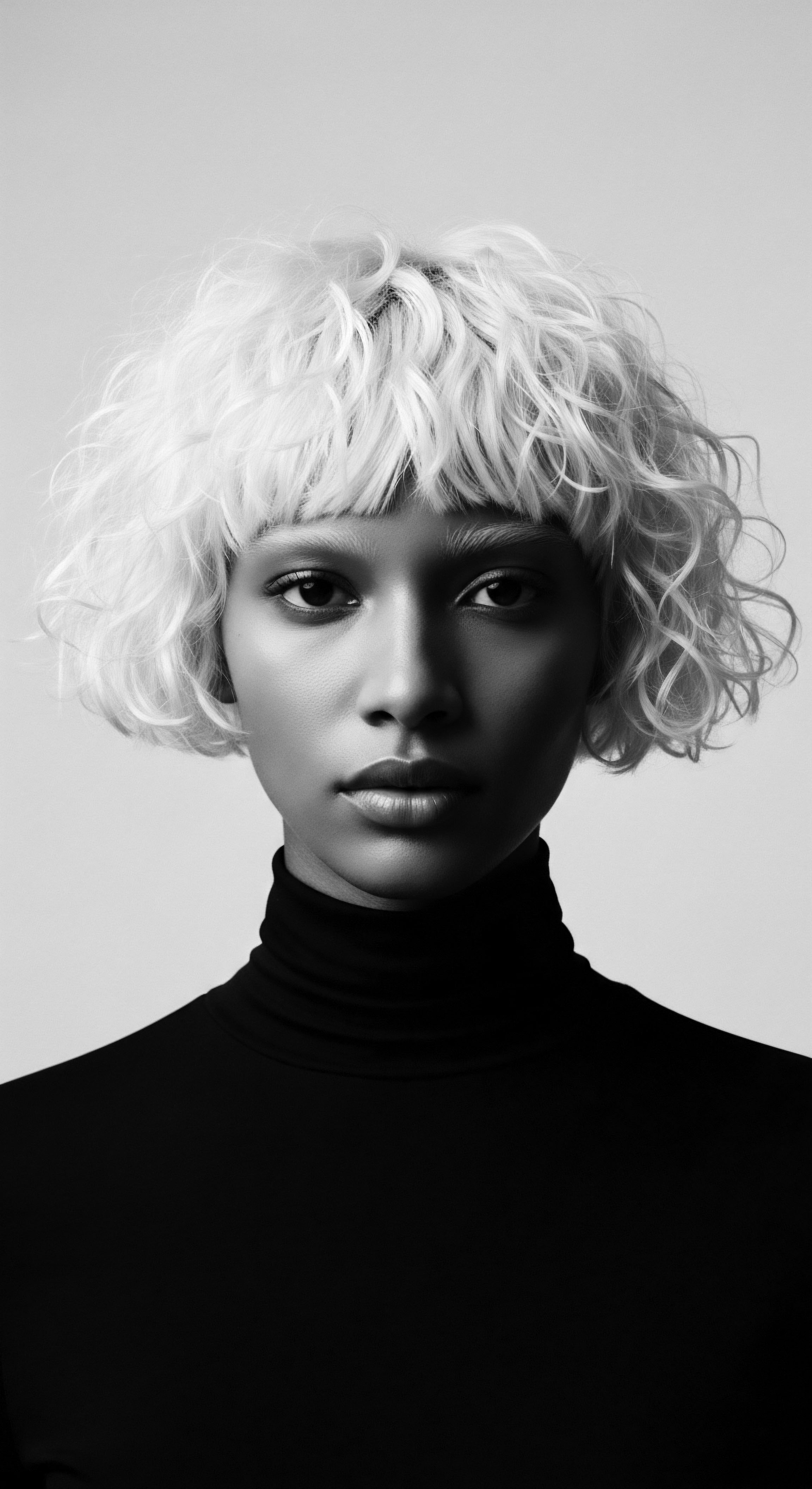
The Basic Composition of Hair
Hair is primarily composed of keratin, a fibrous protein. This protein, in turn, is a long chain of various Amino Acids. The precise sequence and folding of these Amino Acids determine the final shape and properties of the hair strand. Think of it like a complex beaded necklace, where each bead represents a different Amino Acid, and the order of the beads dictates the necklace’s strength and flexibility.
- Keratin Proteins ❉ The primary structural components of hair, forming complex molecular arrangements.
- Cysteine ❉ An Amino Acid particularly abundant in keratin, forming strong disulfide bonds that define hair’s curl pattern and strength.
- Hydrogen Bonds ❉ Weaker than disulfide bonds, yet vital for stabilizing the keratin helices and influencing hair’s moisture properties.
- Salt Bonds ❉ The weakest of the chemical bonds in hair, contributing to its strength and temporarily broken by water.
The intricate interplay of these bonds, formed by the Amino Acids, dictates everything from how much water a hair strand can absorb to its natural curl pattern. For textured hair, this means a delicate balance, where the higher density of disulfide bonds contributes to tighter curls but also can lead to increased vulnerability if not properly cared for.

Intermediate
Moving beyond the foundational understanding, the meaning of Amino Acids within the context of textured hair care expands to encompass their dynamic role in maintaining the hair’s vitality and resilience. These molecular components are not static; they are constantly influenced by both internal physiological processes and external environmental interactions. The protein chains formed by Amino Acids, especially keratin, provide hair with its intrinsic resistance to damage, its capacity to stretch without breaking, and its ability to return to its original shape. This intrinsic resistance is particularly pertinent for textured hair, which, due to its elliptical shaft and unique curl patterns, often experiences more friction and potential points of breakage compared to straighter hair types.
Consider the daily journey of a textured hair strand. Each twist and turn, each gentle detangling motion, relies on the integrity of the Amino Acid bonds within its keratin structure. When these bonds are compromised, perhaps by excessive heat, chemical treatments, or even prolonged exposure to harsh elements, the hair’s natural elasticity diminishes. This leads to increased porosity, making the hair more susceptible to moisture loss and further damage.
Traditional hair care practices, passed down through generations in Black and mixed-race communities, often centered on protective styling and moisturizing regimens. These methods, whether consciously understood or instinctively applied, were profoundly effective in safeguarding the Amino Acid-rich protein structures, thereby preserving the hair’s inherent strength and vibrancy.
Amino Acids provide hair with its dynamic resilience, influencing its elasticity and capacity to withstand daily stressors, a truth reflected in enduring ancestral hair care practices.
The historical significance of hair in various African cultures, where elaborate styles denoted social status, age, or tribal affiliation, underscores the importance of maintaining healthy hair. This was not merely an aesthetic choice; it was a societal imperative. The meticulous care involved in creating and preserving these styles implicitly honored the underlying biological framework provided by Amino Acids.
For instance, the use of natural butters and oils, like Shea Butter in West Africa, provided a protective barrier that helped to seal in moisture and prevent protein loss, indirectly supporting the structural integrity dependent on Amino Acids. Similarly, practices such as African threading techniques for stretching hair without heat offered a gentle approach that preserved the disulfide bonds, unlike chemical relaxers which intentionally break and rearrange these crucial links.

The Role of Specific Amino Acids in Hair Integrity
While all Amino Acids contribute to protein formation, some play more specific roles in hair’s unique properties. Their presence and quantity directly influence the hair’s resilience and how it responds to different environments and treatments.
- Cystine (formed from Two Cysteine Molecules) ❉ This is perhaps the most significant Amino Acid for hair strength. Its sulfur atoms form strong disulfide bonds, creating the cross-links that give hair its shape, rigidity, and resistance to chemical and physical forces. Afro-textured hair is noted for having a higher density of these disulfide bonds.
- Methionine ❉ Another sulfur-containing Amino Acid, Methionine is essential for hair growth and contributes to the overall protein structure. It plays a role in the initiation of protein synthesis and can also be converted to cysteine within the body.
- Arginine ❉ This Amino Acid is found in the hair shaft and is involved in various metabolic processes crucial for hair follicle function. It is a precursor to nitric oxide, which supports blood flow to the scalp, promoting a healthy environment for hair growth.
- Glutamine ❉ While often associated with muscle recovery, Glutamine is also a non-essential Amino Acid that can be synthesized by the body. Research indicates its levels can be affected by chemical treatments on hair, highlighting its role in overall hair protein composition.
The balance of these Amino Acids, whether supplied through diet or topical applications, contributes to the hair’s ability to resist breakage and maintain its structure. A diet rich in protein, for example, ensures the body has the necessary raw materials to synthesize these Amino Acids and build strong keratin.

Historical Applications and Their Modern Interpretations
Ancestral practices, often developed through generations of empirical observation, reveal an inherent understanding of how to support hair’s protein structure. Many traditional ingredients are now recognized for their rich Amino Acid profiles or their ability to protect existing protein bonds.
| Traditional Ingredient/Practice Chebe Powder |
| Cultural Context Chad, Central Africa; used by Basara women for length retention. |
| Amino Acid/Protein Connection Known to be rich in protein and Amino Acids, strengthening hair and reducing breakage. |
| Traditional Ingredient/Practice Rice Water Rinses |
| Cultural Context Ancient Asian traditions, particularly among the Yao women of Huangluo village. |
| Amino Acid/Protein Connection Contains inositol and a spectrum of Amino Acids that repair damaged hair and promote resilience. |
| Traditional Ingredient/Practice Shea Butter (Vitellaria paradoxa) |
| Cultural Context West Africa; a staple moisturizer and protectant for skin and hair. |
| Amino Acid/Protein Connection Rich in fatty acids and vitamins that protect hair from environmental damage, indirectly preserving protein integrity by sealing moisture. |
| Traditional Ingredient/Practice African Olive (Canarium schweinfurthii) Oil |
| Cultural Context Traditional Nigerian hair care. |
| Amino Acid/Protein Connection Rich in essential oils and sulfur-containing Amino Acids like cysteine and methionine, which are growth promoters and increase hair shaft diameter. |
| Traditional Ingredient/Practice These ancestral remedies underscore a profound, intuitive grasp of hair biology, long before modern science articulated the precise role of Amino Acids. |
The ongoing use of these ingredients in modern formulations reflects a beautiful synergy between inherited wisdom and contemporary scientific understanding. The continued exploration of traditional hair care practices offers a rich source of knowledge for developing effective and culturally attuned products that truly honor the unique needs of textured hair.
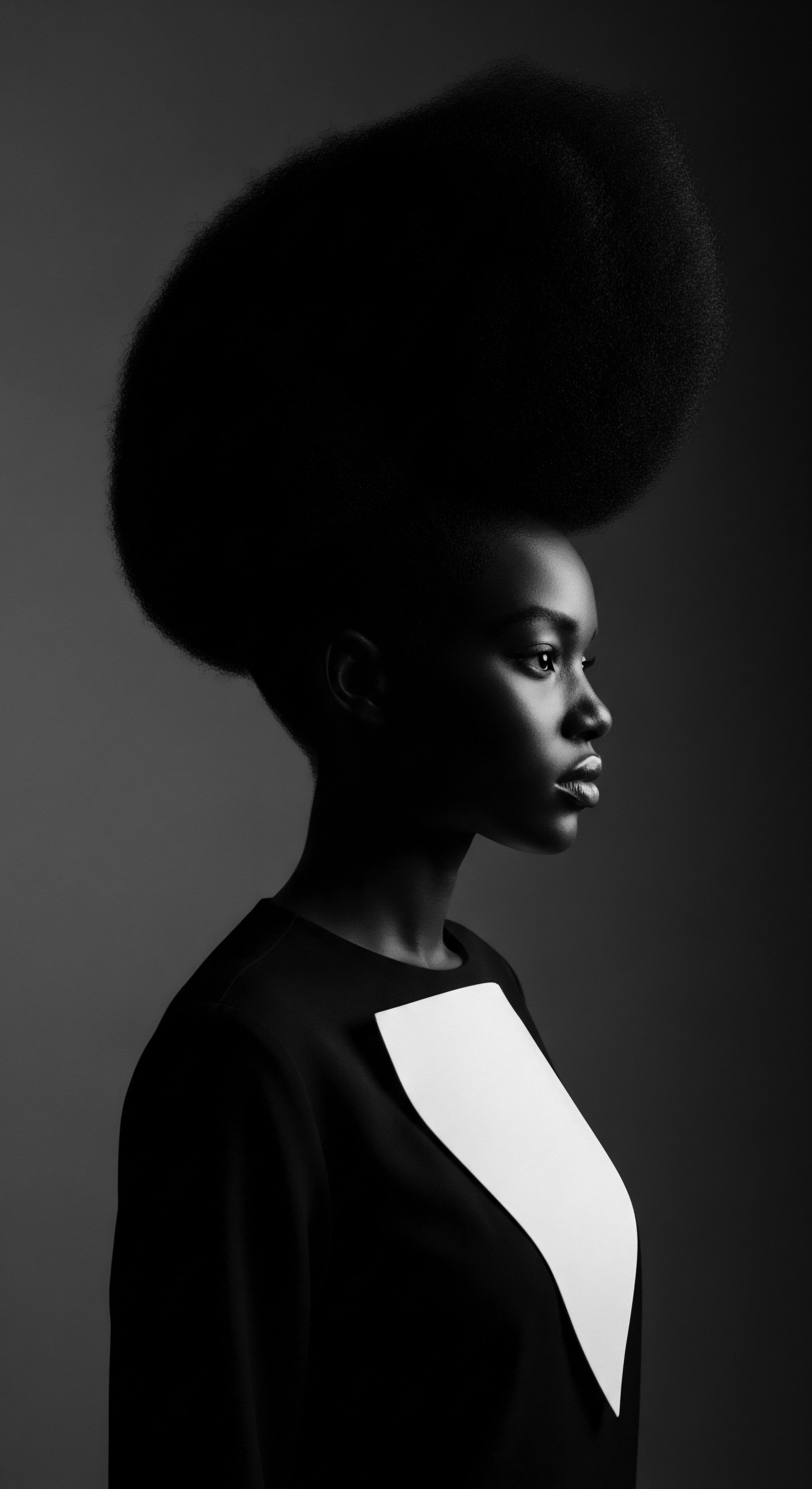
Academic
The academic elucidation of Amino Acids transcends their simple designation as protein building blocks, revealing a profound significance within the complex biophysical and cultural landscape of textured hair. In the realm of hair science, Amino Acids are not merely constituents; they are the architects of keratin’s intricate architecture, dictating the very mechanics of curl formation, resilience, and vulnerability. The inherent structural differences observed in Afro-textured hair, characterized by an elliptical hair shaft and a unique retro-curvature of the follicle, are directly attributable to the distribution and bonding patterns of specific Amino Acids, particularly cysteine. This distinct morphology results in a higher density of disulfide bonds that, while conferring the celebrated coiled structure, also paradoxically creates points of weakness, rendering these strands more susceptible to mechanical damage and moisture loss.
The meaning of Amino Acids, therefore, extends into a critical discourse on hair health disparities and the historical context of Black and mixed-race hair experiences. For centuries, the inherent fragility of textured hair, often exacerbated by environmental factors and societal pressures, necessitated a distinct approach to care. This historical reality led to the development of sophisticated, culturally specific hair care practices that, while predating modern biochemical understanding, intuitively addressed the need to preserve protein integrity. The meticulous processes of oiling, braiding, and protective styling, deeply ingrained in ancestral traditions, served as crucial mechanisms to mitigate breakage and maintain the structural cohesion of Amino Acid-rich keratin.
Amino Acids are the foundational elements of hair’s structural integrity, with their distribution in textured hair dictating its unique curl and inherent vulnerabilities, a reality historically managed through culturally specific care.
A compelling illustration of this interplay between biochemical reality and historical practice emerges from the widespread use of chemical relaxers. These treatments, designed to permanently straighten coiled hair, function by intentionally breaking and rearranging the disulfide bonds formed by cysteine residues within the hair shaft. A study by Khumalo et al. (2000) provides a poignant biochemical insight, observing a significant reduction in cysteine levels in chemically relaxed hair compared to virgin hair.
This reduction in cystine, a key Amino Acid responsible for hair’s intrinsic resistance, directly correlates with increased fragility and susceptibility to damage. The long-term consequences of such chemical alterations, historically driven by Eurocentric beauty standards and the desire for social acceptance, highlight the profound impact on the hair’s fundamental protein structure. This scientific validation of observed hair fragility in chemically treated textured hair underscores the enduring wisdom embedded in ancestral calls for gentler, more protective methods of hair care.
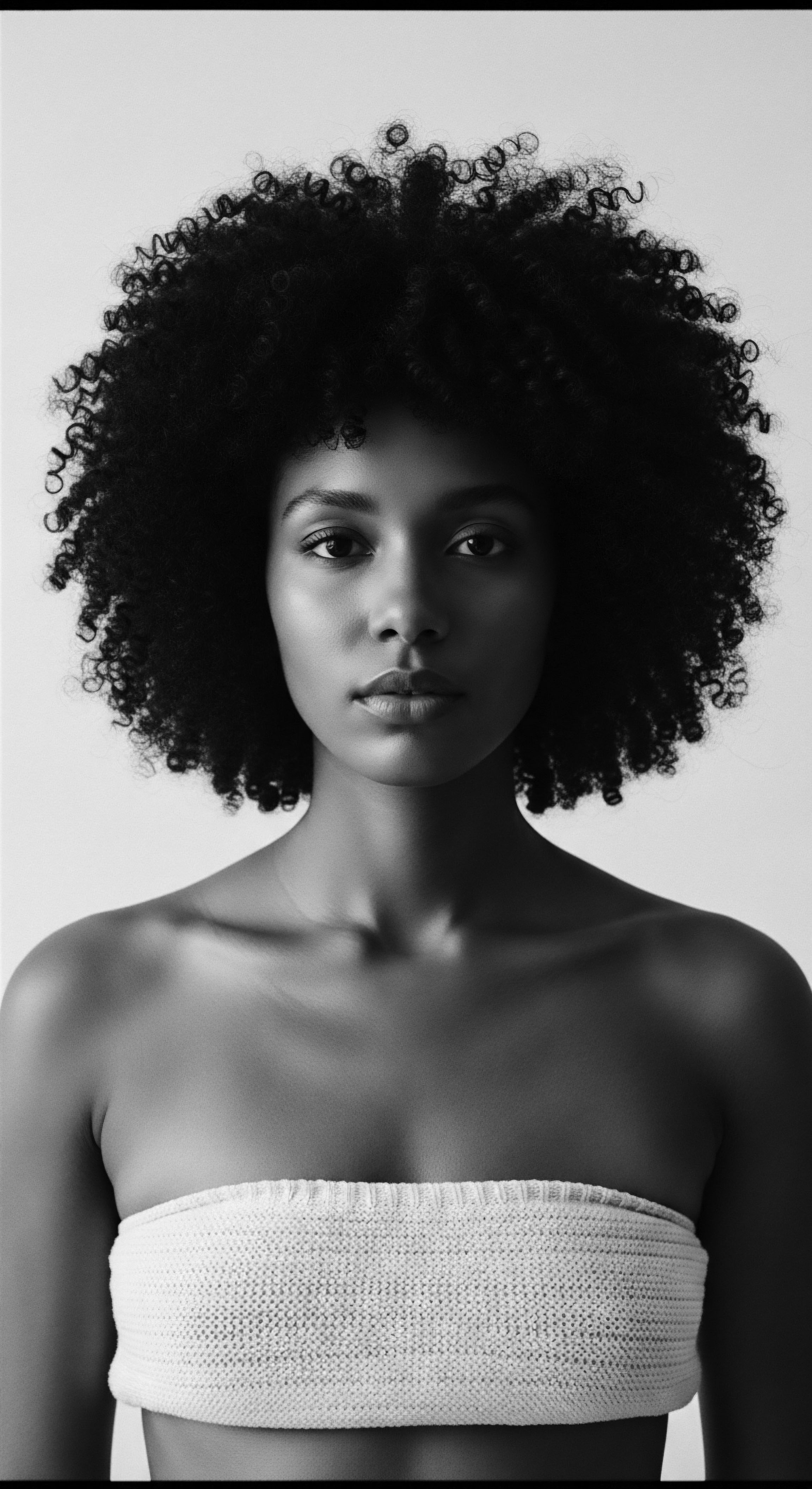
The Biophysical Delineation of Hair Proteins and Amino Acid Interactions
Hair, predominantly keratin, is a marvel of biological engineering, with its properties stemming from the precise arrangement of Amino Acids. Keratin itself is not a single protein but a family of fibrous proteins. These proteins coil into alpha-helices, which then twist around each other to form intermediate filaments. These filaments are further organized into macro-fibrils within the cortex, the main structural component of the hair shaft.
- Disulfide Bonds and Curl Pattern ❉ The disulfide bonds, covalent links formed between two cysteine residues, are the strongest chemical bonds in hair. Their quantity and uneven distribution along the hair shaft are primary determinants of curliness. In Afro-textured hair, the elliptical cross-section of the hair fiber and the asymmetrical S-shape of the follicle lead to a higher density and clustered arrangement of these bonds, creating the tight, resilient coils. This arrangement, while providing unique structural integrity, also makes the hair more prone to tangling and breakage at the points of curvature.
- Hydrogen Bonds and Moisture Dynamics ❉ Hydrogen bonds, weaker than disulfide bonds, are vital for stabilizing the keratin structure and play a crucial role in hair’s interaction with water. They are temporarily broken by water and reformed as hair dries, contributing to hair’s elasticity and its ability to absorb moisture. Textured hair, with its raised cuticle layers, can be more susceptible to moisture loss, making the integrity of these hydrogen bonds, and thus the overall protein structure, paramount for hydration retention.
- Salt Bonds and PH Sensitivity ❉ Salt bonds are electrostatic interactions between charged Amino Acid side chains. They are the weakest of the hair’s bonds and are easily disrupted by changes in pH, as well as by water. The sensitivity of these bonds to pH variations is a significant consideration in hair product formulation, particularly for textured hair, which benefits from pH-balanced products to maintain cuticle health and prevent damage.
The interplay of these bond types, underpinned by the specific Amino Acid profile, defines the mechanical properties of hair. Understanding this molecular architecture provides a scientific basis for traditional hair care practices that emphasized moisture, gentle handling, and protective styling, all of which contribute to preserving these delicate bonds.

The Nutritional and Environmental Context of Amino Acids in Textured Hair
The availability of essential Amino Acids for healthy hair growth is intrinsically linked to nutritional intake. Hair cells are among the fastest dividing cells in the body, making them highly sensitive to dietary deficiencies. A diet lacking in sufficient protein, and by extension, the necessary Amino Acids, can lead to weakened hair strands, increased shedding, and stunted growth.
Historically, access to diverse and nutrient-rich diets varied significantly across different communities, particularly for those in the African diaspora. Despite systemic challenges, many ancestral diets incorporated foods that provided a rich source of protein and essential nutrients for hair health. For instance, traditional African diets often included beans, nuts, and various leafy greens, all recognized sources of protein and minerals like zinc, which are crucial for hair growth and repair. The emphasis on communal eating and the sharing of traditional foods often ensured a baseline nutritional intake that supported overall well-being, including hair vitality.
Beyond diet, environmental factors also exert influence. Exposure to harsh sunlight, pollution, and even the mechanical stress of daily grooming can degrade hair proteins, breaking down Amino Acid bonds. Traditional protective styles, such as braids, twists, and head wraps, served not only as cultural expressions but also as practical shields against these external aggressors, preserving the hair’s delicate protein structure.
The concept of “good hair” within some Black communities, often historically tied to straighter textures, inadvertently led to practices that further compromised the inherent protein structure of textured hair. The widespread use of chemical relaxers, for example, aimed to alter the disulfide bonds, often resulting in increased hair fragility and loss of elasticity. The ongoing natural hair movement represents a profound cultural shift, re-centering the appreciation for naturally coiled and kinky textures and advocating for care practices that respect and fortify the hair’s natural Amino Acid composition. This movement acknowledges that hair health is not about conforming to external ideals, but about nurturing the hair’s inherent biological design.
| Treatment Type Chemical Relaxers |
| Mechanism of Action Utilize strong alkaline chemicals (e.g. sodium hydroxide, guanidine hydroxide) to break disulfide bonds. |
| Impact on Amino Acids/Hair Structure Significant reduction in cysteine levels, leading to increased fragility and reduced tensile strength. Hair becomes more prone to breakage and damage. |
| Treatment Type Traditional Protective Styles (Braids, Twists) |
| Mechanism of Action Minimize daily manipulation, protect ends, and reduce environmental exposure. |
| Impact on Amino Acids/Hair Structure Preserves existing disulfide and hydrogen bonds by reducing mechanical stress and friction, thus maintaining protein integrity and length retention. |
| Treatment Type Heat Styling (High Temperatures) |
| Mechanism of Action Causes water to evaporate rapidly, breaking hydrogen bonds and denaturing proteins. |
| Impact on Amino Acids/Hair Structure Can lead to decomposition of tryptophan residues and irreversible damage to keratin, resulting in dryness and brittleness. |
| Treatment Type Protein Treatments (Hydrolyzed Proteins) |
| Mechanism of Action Deliver broken-down protein fragments (Amino Acids, peptides) that can temporarily fill gaps in the cuticle and cortex. |
| Impact on Amino Acids/Hair Structure Can temporarily strengthen hair, improve elasticity, and reduce porosity by reinforcing damaged protein structures. Often include hydrolyzed wheat, rice, or soy proteins. |
| Treatment Type The scientific understanding of these processes reinforces the ancestral wisdom that prioritized gentle, protective care to maintain the inherent strength and beauty of textured hair. |
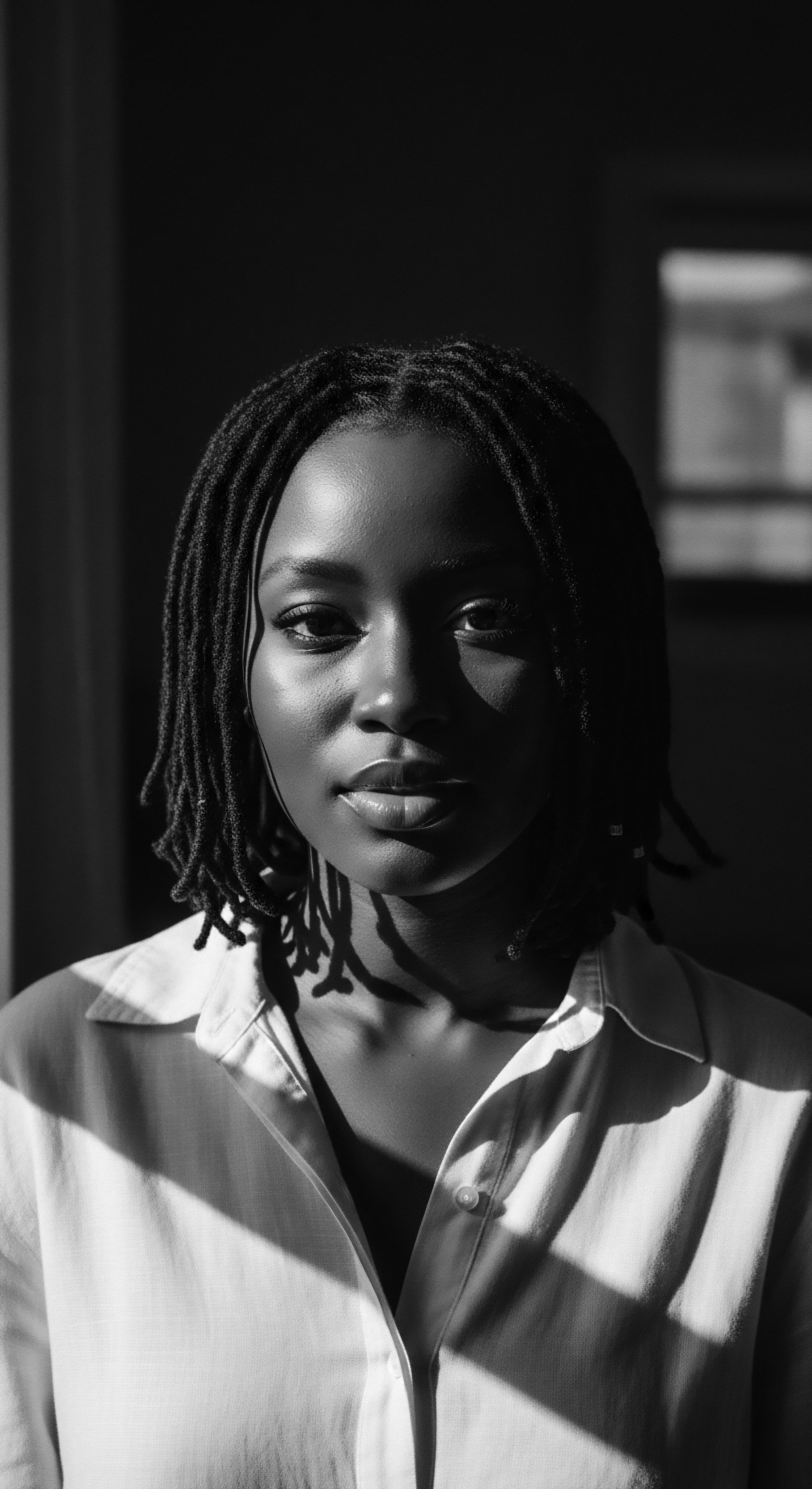
The Unbound Helix ❉ Amino Acids as Markers of Identity and Resilience
The deeper meaning of Amino Acids within the narrative of textured hair is not confined to molecular biology; it is woven into the very fabric of identity and cultural resilience. Hair, particularly for Black and mixed-race individuals, has historically served as a potent symbol of self-expression, a canvas for storytelling, and a declaration of heritage. The structural integrity provided by Amino Acids enables this profound cultural role. When hair is healthy and strong, it can be sculpted into the intricate cornrows that once mapped escape routes during enslavement, or the towering Afros that became a political statement of Black pride.
The journey of textured hair, from forced assimilation during slavery to the powerful reclamation of natural styles today, reflects a continuous dialogue with the intrinsic properties of its Amino Acid composition. The “pencil test” used in apartheid South Africa, a cruel measure of racial classification based on whether a pencil would hold in one’s hair, starkly illustrates how hair texture, a direct consequence of Amino Acid arrangement, became a tool of oppression. Yet, through this adversity, the resilience of Black hair, and by extension, the communities it represents, shines through. The collective wisdom of generations, in preserving hair health through traditional practices, was a quiet, persistent act of defiance and self-preservation.
The academic pursuit of understanding Amino Acids in textured hair, therefore, is not merely about scientific classification. It is about honoring a living legacy of adaptation, innovation, and resistance. It is about recognizing that every coil, every kink, every strand holds a story of survival and triumph, underpinned by the fundamental molecular building blocks that have been nurtured, protected, and celebrated across centuries. This nuanced perspective allows for a more comprehensive and empathetic approach to hair science, one that acknowledges the profound cultural and historical dimensions alongside the biochemical realities.

Reflection on the Heritage of Amino Acids
As we draw our exploration of Amino Acids to a close, the resonant echoes of their journey through time and tradition settle upon us. They are more than mere chemical compounds; they are the very soul of a strand, inextricably linked to the textured hair heritage that Roothea seeks to honor and preserve. From the elemental biology that shapes each coil and kink to the tender care passed down through ancestral hands, the story of Amino Acids is a profound meditation on resilience, identity, and the enduring wisdom of communities.
The insights gleaned from scientific inquiry, when viewed through the lens of heritage, do not diminish the beauty of traditional practices; rather, they affirm them. The ancient use of nutrient-rich plants and oils, the meticulous art of protective styling, and the communal rituals of hair care were not simply acts of grooming. They were acts of preservation, of nurturing the very protein structures that Amino Acids compose, ensuring the continuity of a vibrant cultural legacy. Each braid, each twist, each deeply conditioned strand carries the weight of generations, a silent testament to an intuitive understanding of what hair truly needs to thrive.
The journey of textured hair, often navigating challenging societal landscapes, has been one of constant adaptation and assertion. The Amino Acids within each strand, steadfast in their molecular design, have withstood the pressures of assimilation and the ravages of chemical alteration. Their continued presence, defining the unique textures we celebrate today, speaks to an unbreakable spirit.
Roothea’s ‘living library’ endeavors to ensure that this profound connection, between the scientific underpinnings of hair and its rich ancestral story, remains accessible and revered. This understanding empowers us not only to care for our hair with deeper intention but also to connect with the deep lineage of those who came before us, recognizing that in every strand, there is a heritage to behold.
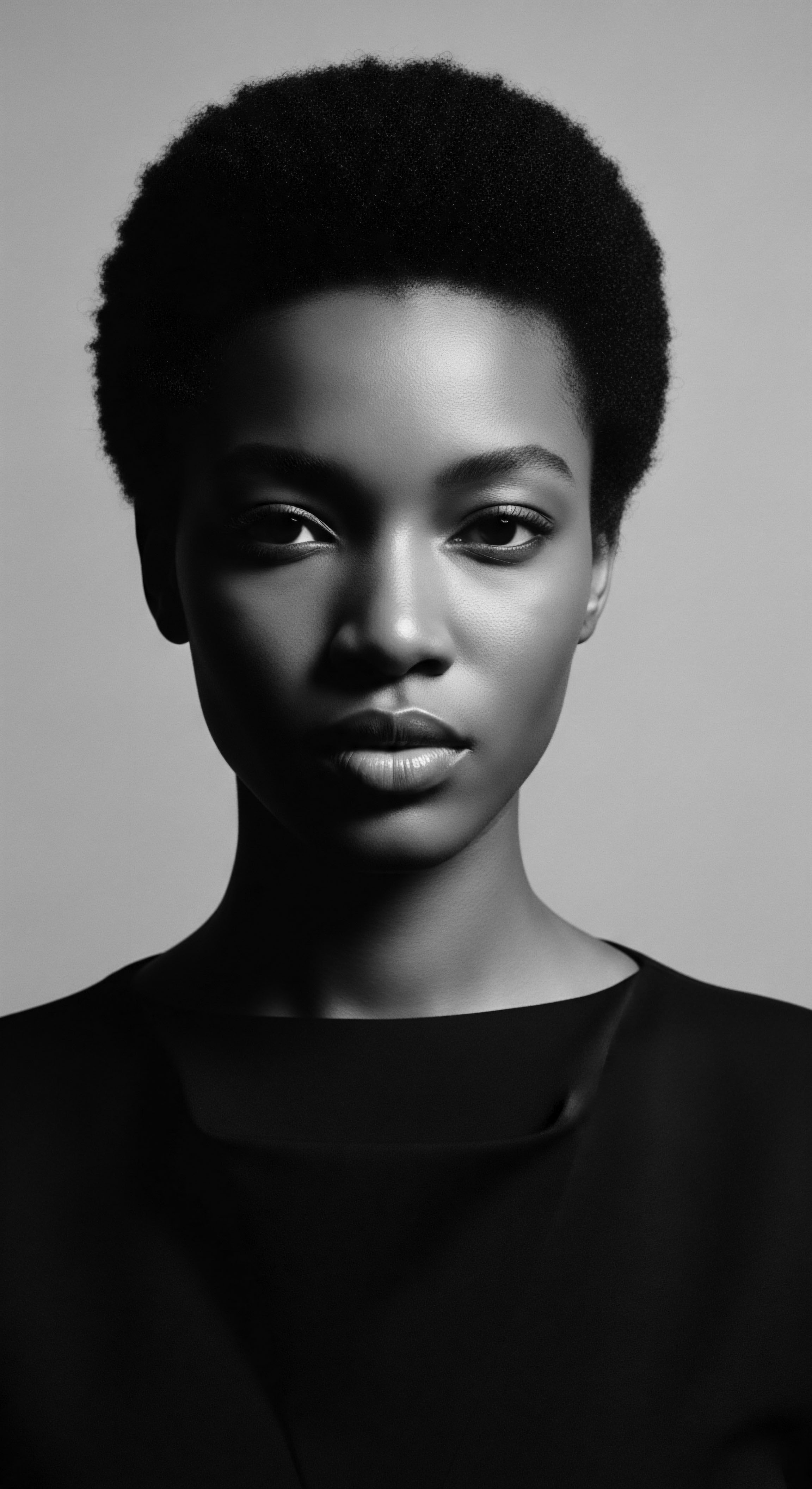
References
- 1. The Genomic Variation in Textured Hair ❉ Implications in Developing a Holistic Hair Care Routine. (2024). MDPI .
- 2. Hair Care Secrets of the Past ❉ What Our Ancestors Used for Healthy Hair. (2024). Hair Care Secrets .
- 3. Rediscovering Historical Hair Care Practices. (n.d.). Fabulive .
- 4. Genomic Variation in Textured Hair ❉ Implications for Holistic Hair Care. (n.d.). Hexis Lab .
- 5. Ancestral Wisdom Meets Modern Formulation in Rice Water Shampoo. (2023). My Sasun .
- 6. African Foods for Healthy Skin and Hair. (2024). My Sasun .
- 7. Dermatologists Advocating for Inclusive Hair Loss Research and Treatment in the African Diaspora. (2025). American Journal of Managed Care .
- 8. Biology Of The Kink ❉ What Makes Curly Hair Curl?. (2022). Afrocenchix .
- 9. Essential Guide To Curly & Afro-Textured Hair. (n.d.). The Solid Bar Company .
- 10. Khumalo, N. P. et al. (2000). ‘Relaxers’ damage hair ❉ Evidence from amino acid analysis. International Journal of Dermatology .
- 11. 5 Reasons Natives Have Lustrous Locks ❉ Ancient, Indigenous Hair Remedies. (2014). ICT News .
- 12. African Hair Care. (n.d.). Africa Imports .
- 13. Hair Care Practices from the Diaspora ❉ A Look at Africa, America, and Europe. (2025). Layla & Kays .
- 14. The Evolution of Black Hair Products ❉ A Journey from Homemade Remedies. (2024). Safo Hair .
- 15. Exploring Ancient Hair Care Rituals ❉ Timeless Practices for Modern Hair Wellness. (2024). Rthvi .
- 16. A Review Of Indigenous Therapies For Hair And Scalp Disorders In Nigeria. (2024). ResearchGate .
- 17. How Historical Hair Care Grew My Hair to Thigh Length After Modern Methods Failed. (2025). Katherine Haircare .
- 18. Celebrating Diversity ❉ Cultural Influences on Hair. (2024). Fix Salon .
- 19. The Science Behind The Keratin Lab. (2024). The Keratin Lab .
- 20. Model of hair keratin using Martini force field ❉ a) and b) with the presence of hair lipids (free fatty acids), represented in a) with the spheres, c) after the removal of the lipids. (n.d.). ResearchGate .
- 21. Historical Perspectives on Hair Care and Common Styling Practices in Black Women. (2025). PMC .
- 22. Historical Hair Care Grew My Hair to Hip Length! Here’s How. (2022). Katherine Haircare .
- 23. Ethnobotanical and Pharmacological Importance of the Herbal Plants With Anti-Hair Fall and Hair Growth Activities. (2020). ResearchGate .
- 24. ECLIPTA ALBA (BHRINGRAJ) ❉ A PROMISING HEPATOPROTECTIVE AND HAIR GROWTH STIMULATING HERB. (n.d.). International Journal of Applied Pharmaceutics .
- 25. THE HAIR ❉ Structure and Ethnic Specificities. (n.d.). Silkbiotic .
- 26. Ethnobotanical and Pharmacognostic Perspective of Plant Species Used as Cosmetics in Cameroon. (2015). Scribd .
- 27. Mastering Protein Selection ❉ Unlocking the Secrets to Optimal Hair Care Solutions. (2024). Croda .
- 28. This Homemade Afro Hair Product is 10x Better than Just Shea. (2025). Katherine Haircare .
- 29. The Long and Short of Protein Hair Treatments. (2023). The Voice Of Fashion .
- 30. Hair Treatment Cream 12 em 1. (n.d.). Skala Cosméticos .
- 31. Hair Care. (n.d.). National Museum of American History .
- 32. Textured Tresses Worldwide ❉ Celebrating the Global Diversity of Hair. (n.d.). Layla & Kays .
- 33. Afro Hair Care – The Ultimate Guide for 2022. (2022). Afrocenchix .
- 34. Afro-textured hair. (2023). EBSCO Research Starters .
- 35. Biometrics from the Isotopic Analysis of Amino Acids in Human Hair. (n.d.). Office of Justice Programs .
- 36. ‘Relaxers’ damage hair ❉ Evidence from amino acid analysis. (n.d.). ResearchGate .
- 37. Kinky, curly hair ❉ a tool of resistance across the African diaspora. (2016). USC Dornsife .
- 38. African-American hair. (n.d.). Wikipedia .
- 39. Hair Cosmetics ❉ An Overview. (n.d.). PMC .
- 40. Naturally Occurring Proteins That are Great for the Hair. (n.d.). Simply Organic Beauty .
- 41. The Power of Hair Across Cultures ❉ A Symbol of Identity and Expression. (2024). Beauty By Earth .
- 42. Role of Nutrition in Healthy Black Hair Growth. (n.d.). My Sasun .
- 43. Discover the Power of Elastin Protein ❉ A New Revolutionary Hair Treatment at Salon Nayana. (2025). Salon Nayana .
- 44. Alternatives to Traditional Keratin Treatments ❉ Safer and Natural Options. (2024). Kera Mane .
- 45. Maintaining Lustrous Black Hair at 40 ❉ Diet and Lifestyle Tips. (2024). OnlyMyHealth .
- 46. Black Hair Care and Its Culture, a story. (n.d.). African American Registry .
- 47. West African Herbal Pharmacopoeia. (n.d.). West African Health Organization .
- 48. History of Black Hair Care. (n.d.). Never the Less Inc .
- 49. Diet and hair loss ❉ effects of nutrient deficiency and supplement use. (n.d.). PMC .
